The Algo Device Management Platform (ADMP) is a cloud-based device management solution for managing, monitoring, and configuring Algo IP endpoints from any location. Service providers and system administrators can use ADMP to effectively manage Algo IP endpoints in large environments across multiple locations and networks.
Note
Devices must have firmware version 5.2 or higher installed to be managed with ADMP. To access all the latest ADMP features, devices must be on the most recent firmware version available.
Setting up Your Account
To use ADMP, you must set up your account, users, and licenses.
Account Tiers
There are three types of ADMP accounts:
Trial | A Trial account is a free 3-month account with access to 25 device licenses. To sign up for a trial account, fill out the form at https://www.algosolutions.com/admp-demo-license/. |
Pro | A Pro account uses device licenses that have been purchased or renewed. An Algo Support team member does setup for a Pro account after you’ve purchased device licenses. Device licenses may be purchased at https://www.algosolutions.com/product/admp/. |
Perpetual | A Perpetual account is available for Algo Authorized Integrators. To learn more about the Algo Authorized Integrator Program, visit https://www.algosolutions.com/integrator/. |
After you have signed up for a demo, purchased ADMP device licenses, or have become an Algo Authorized Integrator, an Algo Support Team member will reach out to set up account users.
User Permissions
You can access an ADMP account as either an Admin or a Viewer.
This table lists their different permissions.
Admin | Viewer |
An admin can access the following pages and perform actions where applicable.
| A viewer will only be able to view the following pages. Actions cannot be performed.
|
The Algo Support team will be able to assist with adding new users, removing users, and updating user types upon request. There is no limit to the number of users you can have on an account. To add or remove users, the account owner should contact support@algosolutions.com for assistance.
Licenses
ADMP licenses are per device, not per person or account. Device licenses are purchased and renewed annually in bundles of 25. An account can have up to 10,000 licenses.
You may purchase additional device licenses through an Algo reseller, distributor, or on the Algo website here: https://www.algosolutions.com/product/admp/.
Multi-Tenant
To enable multi-tenancy, please reach out to the Algo support team at support@algosolutions.com.
Multi-tenancy allows ADMP account holders to manage multiple deployments, or tenant accounts, from one main ADMP account. When multi-tenancy is in use, an ADMP account holder will log into ADMP and select the tenant account to view. From here, a user can monitor and manage devices connected to a tenant account.
Tenant Account Permissions
Permissions differ based on the type of tenant account.
The number of tenant accounts an ADMP account can have is unlimited.
To set up a new tenant, please contact the Algo Support Team at support@algosolutions.com.
The table below outlines the available permissions for each user type.
User Type | Permissions |
Administrator |
|
Additional Users |
|
Single Sign-On
To enable SSO, please contact the Algo support team at support@algosolutions.com.
Single sign-on (SSO) for ADMP is available through a Microsoft account. SSO makes ADMP access seamless for designated users while improving account security. To provide SSO, ADMP uses Azure Active Directory (Azure AD), Microsoft’s enterprise cloud-based identity and access management (IAM) solution.
Note
A current limitation of SSO in ADMP is that one Azure AD can only be associated with one ADMP account, but not each tenant account. For example, a service provider who uses multiple tenant accounts for each of their customers can only have one Azure AD for their main account. Each customer, or tenant, cannot also use the same Azure AD separately.
However, a main account and tenant account may use separate Azure ADs, allowing SSO to be used for both a main account login or a single tenant login.
Setting up SSO
Before setting up SSO, it should be noted that users with SSO will no longer be able to log in using a password. Only one login option can be applied to an account.
To set up SSO:
Sign in to the Microsoft Entra admin center as at least a Cloud Application Administrator.
Go to Users and select + New user → Create new user.
.png)
Configure the new user information and then select Review + create.
.png)
Repeat this process to add more users.
Go to Enterprise apps.
Click All applications, then select + New application.
.png)
Click + Create your own application.
.png)
Configure the following, then select Create.
.png)
Enter your application name.
Select Integrate any other application you don't find in the gallery (Non-gallery).
Select Set up single sign on.
.png)
Select SAML as the single sign-on method.
.png)
Select Edit for Basic SAML Configuration.
.png)
Configure the basic SAML settings and then select Save.
Select Add Identifier and enter
urn:amazon:cognito:sp:us-east-1_29zRSC27FSelect Add reply URL and enter:
https://admp.auth.us-east-1.amazoncognito.com/saml2/idpresponseEnter Sign on URL:
https://dashboard.cloud.algosolutions.com
.png)
Go back to Single sign-on and select the Copy icon
.png) to obtain the App Federation Metadata URL.
to obtain the App Federation Metadata URL..png)
Provide the Algo Support team with the App Federation Metadata URL from the previous step.
Select Edit under Attributes & Clarims.
.png)
Select Unique User Identifier.
.png)
Change the Source to Transformation.
.png)
Set the transformation, then select Add.
.png)
Transformation: Set as
ToLowercase().Parameter 1: Set as Attribute.
Attribute name: Set as
user.userprincipalname
Select Add.
Using SSO
When SSO is set up, you can access ADMP via https://dashboard.cloud.algosolutions.com/sso. The login page will look slightly different from https://dashboard.cloud.algosolutions.com/sso. The login page will look slightly different than the regular ADMP login page.
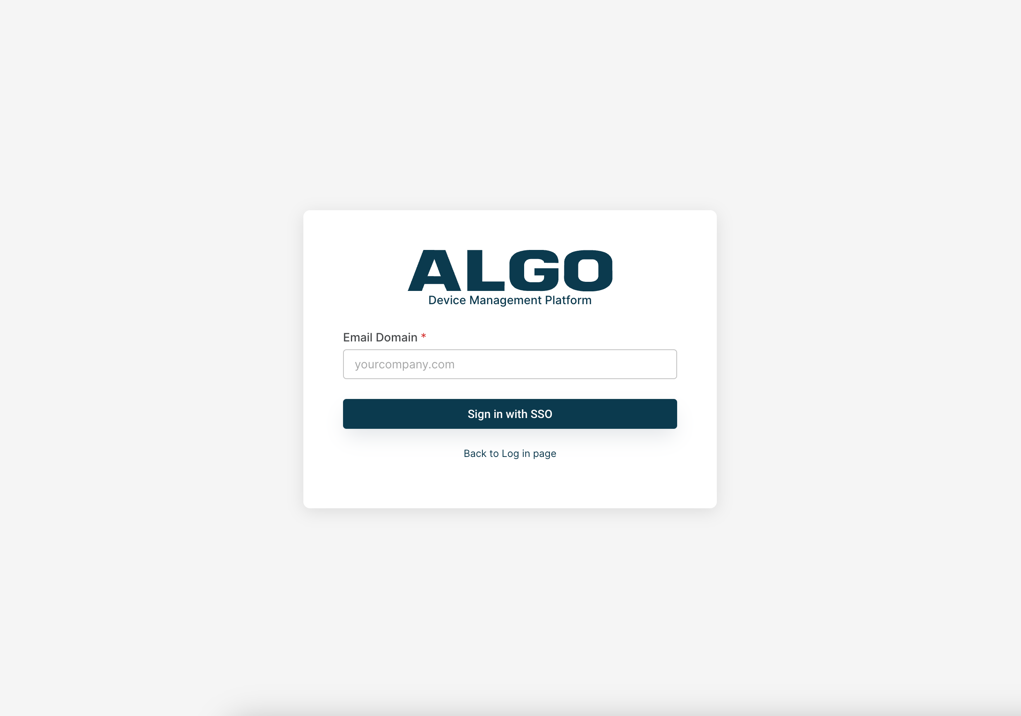
To log in using SSO:
Enter the domain of your email.
For example, instead of support@algosolutions.com, you would enter algosolutions.com.
You will be redirected to a Microsoft login if you are not already logged in to your Microsoft account.
Once you enter your credentials, you’ll be redirected back to ADMP to access your account.
Getting Started
Once your ADMP account is set up, you will receive login credentials via email.
The email will be sent from no-reply@cloud.algosolutions.com and will contain your username and password.
.png)
Logging in to ADMP
You must log in to ADMP to manage or monitor your devices.
To log in to ADMP:
Open a web browser and go to: https://dashboard.cloud.algosolutions.com/.
Enter your user name and password, and then select Sign in.
On your first login, follow the on-screen instructions to change your password.
Viewing Tenant Accounts
You can view detailed information about available tenant accounts and switch between different accounts.
To view ADMP tenant accounts:
Log in to the ADMP application.
Select the Enter icon
 on the right of the desired account panel.
on the right of the desired account panel.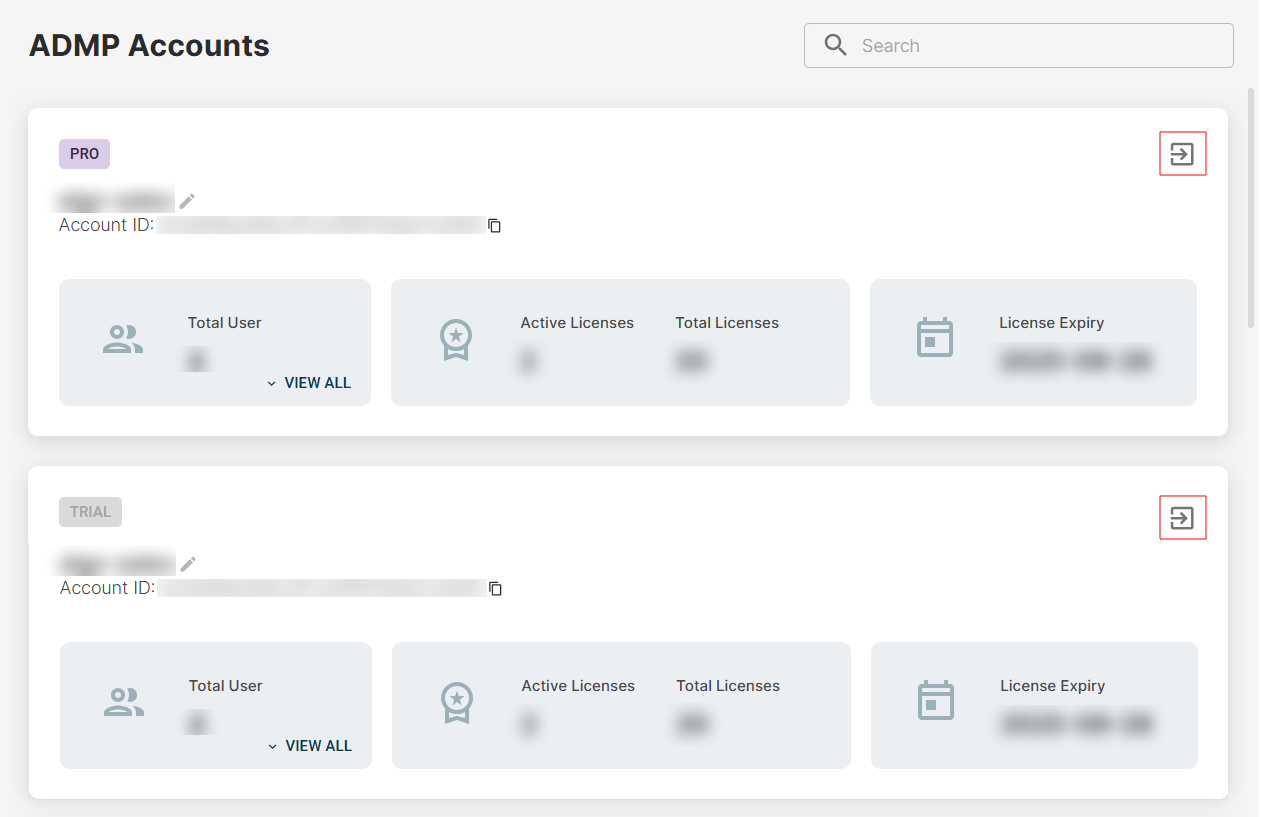
To go back to the Account Manager:
Select BACK TO ACCOUNT LIST on the top right of the page.
.png)
Obtaining Your ADMP Account ID
Each tenant account has a unique ID. You must provide the account ID when:
Connecting your device to ADMP.
Contacting Algo support to request ADMP-related assistance.
To obtain the ADMP account ID:
Log in to your ADMP application.
Select your Account icon
 to view the account info.
to view the account info.To copy the account ID, select the Copy icon
 .
.
Connect an Algo IP Device to ADMP
To monitor your devices in ADMP, you must first connect them to your account. You can do this manually using the web interface for each endpoint or via zero-touch provisioning.
Adding Algo Devices Manually to ADMP
To manually connect an Algo IP endpoint, you must enable ADMP Cloud Monitoring from the device web interface.
.png)
To enable ADMP Cloud Monitoring for an Algo device:
Log in to the device web interface.
Go to Advanced Settings → Admin.
Under ADMP Cloud Monitoring, select Enabled for Enable ADMP Cloud Monitoring.
Enter your ADMP account ID in Account ID.
To allow ADMP to query and display settings stored on the device, select Allow Configuration File Sync.
Specify how often ADMP should check the status of your device in Heartbeat Interval.
Select Save.
After a few minutes, your Algo device will be connected to ADMP.
On the Status tab of the device web interface, you should see ADMP Cloud Monitoring set to Connected.
Your device will also now be listed on the Devices page of ADMP.
Using ZTP to Bulk Add Devices to ADMP
In large-scale deployments, Zero Touch Provisioning (ZTP) can automatically bulk add devices to the ADMP, eliminating the need to manually enable ADMP Cloud Monitoring on each unit.
For more information, see Zero-Touch Provisioning (ZTP)
Dashboard
When you log into your ADMP account, the Dashboard page appears first.
It provides a summary of your connected Algo IP endpoints.
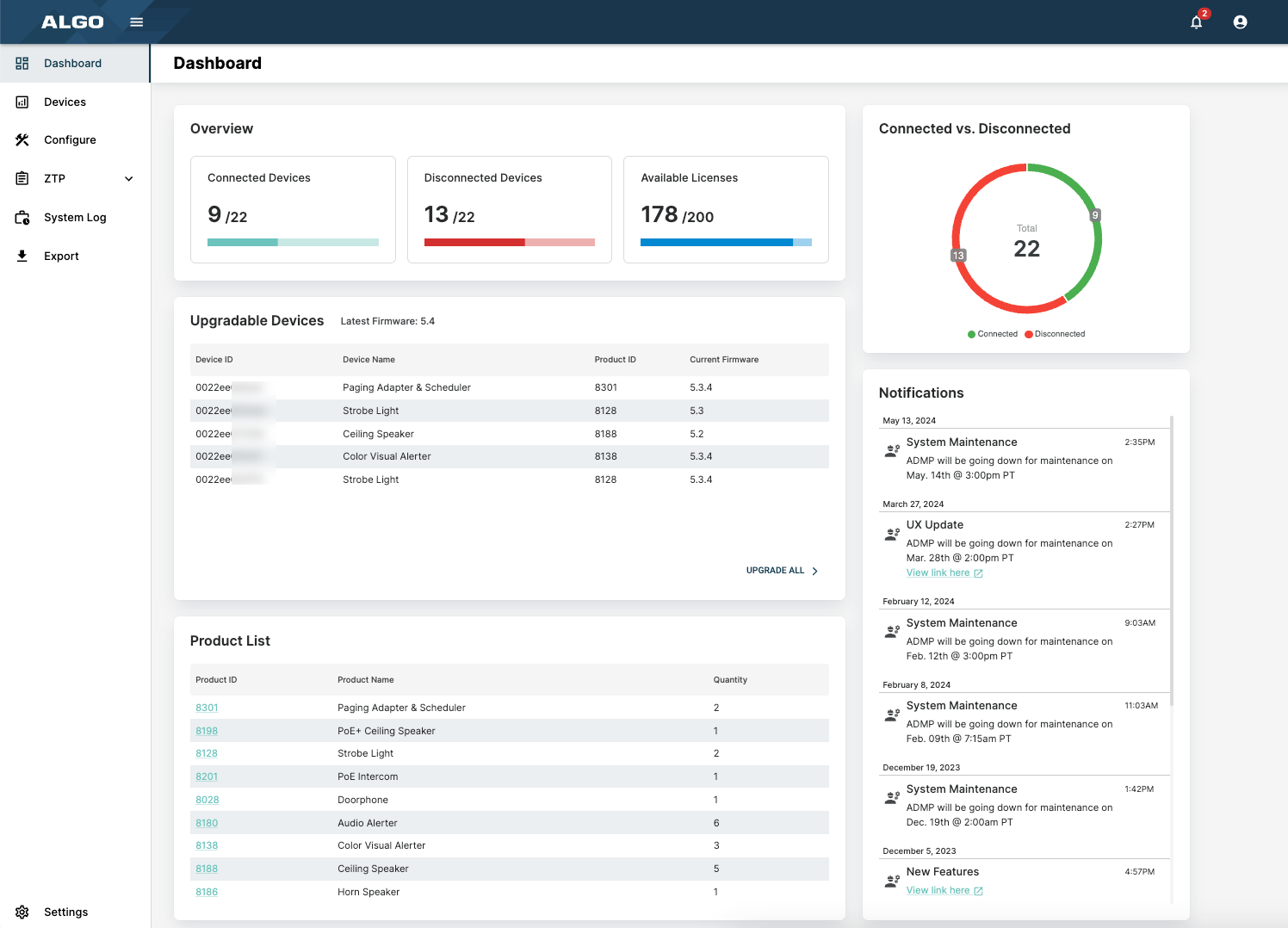
Overview
The Overview section displays a quick summary of the count of your devices and licenses.

Item | Description |
|---|---|
Connected Devices | The number of connected devices compared to the total number of detected devices, including those connected and disconnected. |
Disconnected Devices | The number of disconnected devices compared to the total number of detected devices, including those connected and disconnected. |
Available Licenses | The remaining device licenses you have available to manage additional Algo IP endpoints from ADMP. |
Upgradable Devices
Devices listed here have new firmware available. You can install the latest firmware directly through ADMP.
.png)
Item | Description |
|---|---|
Device ID | The MAC address of your device. |
Device Name | The product name of your device. |
Product ID | The SKU number of your device. |
Current Firmware | The firmware version the device is currently using. |
Updating Device Firmware
You can update firmware for a single device or perform a batch upgrade for multiple devices.
To upgrade device firmware:
Log in to your ADMP application.
On the Dashboard page, go to the Upgradable Devices section.
Select UPGRADE ALL.
Select desired devices.
Check the Latest Firmware to ensure this is the firmware version you want.
Select Upgrade.
The selected devices disappear from the Upgradable Devices section.
On the Devices page, their Status changes to UPGRADING
.png) . Upon successful upgrade, the Status changes to CONNECTED
. Upon successful upgrade, the Status changes to CONNECTED .png) .
.
Using Searching and Filtering
The search and filter functions are available on many pages of the system.
Key features include:
Partial search
You can search using partial tag text, MAC address, IP address, product model, firmware version, connection status, and more.
 (1).png)
Logical operators
When selecting multiple tags, you can use the logical operators AND and OR to create more advanced search conditions.
.png)
Product List
The Product List shows all device models connected to ADMP in your deployment and the quantity of devices for each model.
.png)
Entry | Description |
|---|---|
Product ID | The SKU number of your device. |
Product Name | The product name of your device. |
Quantity | The number of deployed devices of the listed product. |
Connected vs. Disconnected
A pie chart that represents the connected and disconnected devices.
The Connected status indicates that the device has ADMP Cloud Monitoring enabled and is currently online.
The Disconnected status indicates that the device has ADMP Cloud Monitoring disabled, is offline, or both.
.png)
Notifications
The Notifications section on the Dashboard displays essential updates such as system outages, upcoming changes, and new ADMP features.
Note
Check this section regularly because these notifications are not sent by email.
.png)
Managing Devices
Use the Devices page to manage and maintain all connected devices.
You can delete devices, add tags to a device, search, or filter devices.
You can view three lists: ALL, CONNECTED, and DISCONNECTED.
Entry | Description |
|---|---|
Device ID | Each Algo device has a unique ID. This ID is the same as the device MAC address. |
Local IP | The IP address of each device used to access the device's web interface. If you are using ADMP on a different network than the one the device is using, you may not be able to reach this IP address. |
Name | The device name or hostname registered in the device web interface. |
Product | The SKU number of your device. |
Firmware | The firmware version the device is currently using. |
Tags | Customizable tags used to easily group devices together based on location, use, or any other preference. |
Status | Each device will show its status as Connected or Disconnected. When an action is in progress, the status will appear as Rebooting, Upgrading, Configuring, Setting, Deleting, Downloading, or Trying. |
Using Tags
You can add tags to devices to include more device information, such as location, function, or department.
For example, tagging a device with “Hallway” makes it easier to locate the device from the device list.
You can:
Create, assign, and remove tags for a device on the Devices page.
Modify or delete a tag's text or color on the Configure page.
.png)
Adding Tags to Devices
Each device can have up to 8 tags. You can create and use up to 100 tags across all devices.
Note
Tags created from the Devices page has the default color blue. To create tags with other colors, create tags from the Configure page.
To add a tag to a device:
Log in to your ADMP application.
Go to the Devices or Configure page.
Select the desired devices.
Select ADD TAG to see a drop-down list of existing tags.
Do one of the following:
Select an existing tag from the list.
Type a new tag and click +Create tag to create and apply a new tag.
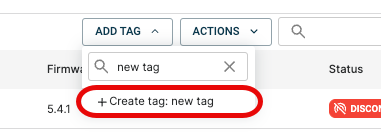 Selected tags are applied to the chosen devices, unless the device already has eight tags.
Selected tags are applied to the chosen devices, unless the device already has eight tags.
Removing Tags from a Device
You can remove tags from a device.
.png)
To remove a tag from a device:
Log in to your ADMP application.
Go to the Devices page.
In the device list, select the Delete icon
 on the desired tag.
on the desired tag.
Applying Actions on Devices
You can manage online devices on the Devices page. For example, upgrading or rebooting devices.
You can apply an action in one of the following ways:
Applying an action from the ACTIONS drop-down list
You can apply an action to multiple devices at a time.
.png)
Applying an action from the More
 menu of a device
menu of a deviceYou can apply actions to individual devices.
Note
Some device-specific actions are only available through the More menu
 .
..png)
Note
All actions except Delete and Add tag are available only when the device status is CONNECTED
.
Testing Devices
You can run a test to verify that a device is working properly.
The test results vary depending on the device type.
When a test is performed:
IP Speakers, IP Displays, Intercoms: The default tone plays.
Paging Adapters: A tone plays if the device is connected to an audio device.
Visual Alerters: The strobe light flashes.
To test devices:
Log in to your ADMP application.
Go to the Devices page.
Select the CONNECTED tab.
Do one of the following:
To test a single device, select it and then select Test from the More
.png) menu or the ACTIONS drop-down list.
menu or the ACTIONS drop-down list.To test multiple devices, select the devices and then select Test from the ACTIONS drop-down list.
Rebooting Devices
You can reboot a device from ADMP. This will not reset the device’s settings.
To reboot devices:
Log in to your ADMP application.
Go to the Devices page.
Select the CONNECTED tab.
Do one of the following:
To reboot a single device, select it and then select Reboot from the More
.png) menu, or from the ACTIONS drop-down list.
menu, or from the ACTIONS drop-down list.To test multiple devices, select the devices and then select Reboot from the ACTIONS drop-down list.
Upgrading Devices to a Specified Firmware Version
You can upgrade device firmware to a specified version.
You can also bulk upgrade devices to a newer firmware version for the same product model.
Note
You can not downgrade the firmware.
To upgrade devices to a specified firmware version:
Log in to your ADMP application.
Go to the Devices page.
Select the CONNECTED tab.
Do one of the following:
To upgrade a single device, select it and then choose Upgrade from the More
.png) menu, or from the ACTIONS drop-down list.
menu, or from the ACTIONS drop-down list.To upgrade multiple devices of the same product model, select the devices and then choose Upgrade from the ACTIONS drop-down list.
Enter the firmware file path URL.
The firmware version must be higher than the current one. Otherwise, the upgrade action will fail.
Select Upgrade.
During the upgrade, the selected devices disappear from the CONNECTED tab.
On the Devices → ALL tab, page, their Status changes to UPGRADING
.png) . After a successful upgrade, the new firmware version displays.
. After a successful upgrade, the new firmware version displays.
Upgrading Devices to the Latest Firmware
You can upgrade selected devices to the latest firmware from the Algo firmware server.
You can also bulk upgrade devices to the latest firmware version for the same model.

To upgrade a device to the latest firmware:
Log in to your ADMP application.
Go to the Devices page.
Select the CONNECTED tab.
Do one of the following:
To upgrade a single device, select it and then choose Upgrade Latest from the More
.png) menu, or from the ACTIONS drop-down list.
menu, or from the ACTIONS drop-down list.To upgrade multiple devices, select the devices and then select Upgrade Latest from the ACTIONS drop-down list.
Select Upgrade.
The selected devices disappear from the CONNECTED tab.
On the Devices → ALL tab, page, their Status changes to UPGRADING
.png) . After a successful upgrade, the firmware version is updated automatically.
. After a successful upgrade, the firmware version is updated automatically.
Pushing Configurations to Devices
You can push configurations onto selected devices.
When processing a configuration file, the system applies changes as follows:
Valid parameters with valid values: Values are applied to the applicable devices.
Valid parameters with invalid values: No changes are made.
Invalid parameters: Parameters remain in the configuration file but do not affect device settings.
Parameters not included in the file: Existing device settings remain unchanged.
Note
Partial configuration files are best for bulk configuration updates.
If you plan to use multicast, you should not push the same configuration file to all devices. Your sender and receiver devices will require different configurations.
Creating a Configuration File
You can create a custom configuration file and upload it to ADMP.
To create a configuration file:
Do one of the following:
Create a plain text file and add the parameters you want to update.
Download the configuration file of a device and change the desired parameter settings.
Save the file as a
.txtfile.Log in to your ADMP application.
Go to File Manager → Files→ Configs.
Drag and drop your
.txtfile into the Configs folder.Now the file is available in the Select a configuration file drop-down list when you select Push Config for a device.
Related Links:
Pushing Configurations to a Device
You can push a configuration file to an individual device or multiple devices simultaneously.
.png)
To push configurations to a device:
Log in to your ADMP application.
Go to the Devices page.
Select the CONNECTED tab.
Do one of the following:
To push configurations to a single device, select it and then select Push Config from the More
.png) menu, or from the ACTIONS drop-down list.
menu, or from the ACTIONS drop-down list.To push configurations to multiple devices, select the devices and then select Push Config from the ACTIONS drop-down list.
Select a configuration file.
Select Confirm.
The selected devices disappear from the CONNECTED tab.
On the Devices → ALL tab, page, their Status changes to CONFIGURING
.png) during the setting update.
during the setting update.The selected devices will reboot to apply the configuration changes.
Setting Device Volume
You can set the ring and page volumes for speakers and paging adapters.
The Ring Volume and Page Volume can be set from -5 to 10.
From -5 to 10, each level increases the volume by 3 dB, with the lowest setting (–5) 45 dB below the maximum (10).
To set device ring and paging volume:
Log in to your ADMP application.
Go to the Devices page.
Select the CONNECTED tab.
Do one of the following:
To change the volume for a single device, select it and then select Set Volume from the More
.png) menu, or from the ACTIONS drop-down list.
menu, or from the ACTIONS drop-down list.To change the volume for multiple devices, select the devices and then select Set Volume from the ACTIONS drop-down list.
Set the Ring Volume and Page Volume.
Select Confirm.
Deleting Devices
You can remove devices from ADMP to stop monitoring them.
Note
Deleting a connected device causes it to reboot if the device firmware is lower than version 5.5.
To delete devices from ADMP:
Log in to your ADMP application.
Go to the Devices page.
Do one of the following:
To delete a single device, select it and then select Delete from the More
.png) menu, or from the ACTIONS drop-down list.
menu, or from the ACTIONS drop-down list.To delete multiple devices, select the devices and then choose Delete from the ACTIONS drop-down list.
Select DELETE to confirm the action.
Devices with a firmware version lower than 5.5 will reboot.
In the device web interface, ADMP Cloud Monitoring now shows as Disabled.
Downloading System Log
You can download system logs to assist with troubleshooting, monitoring, or system auditing.
When downloaded, a .txt file containing your device’s events and messages is saved to your computer’s default download folder.
For Windows users, the file is typically saved to: C:\Users\<USERNAME>\Downloads.
The file name follows this format: <device-mac>-syslog.txt.
To download the system log:
Log in to your ADMP application.
Go to the Devices page.
Select the CONNECTED tab.
Select Download Config from the More
.png) menu of the desired device.
menu of the desired device.
Downloading Device Configuration File
You can download the device configuration file to check the configurations or to customize them.
When downloaded, a .txt file containing your device’s system configurations is saved to your computer’s default download folder.
For Windows users, the file is typically saved to: C:\Users\<USERNAME>\Downloads.
The file name follows this format: <device-mac>-config.txt.
To download the system log:
Log in to your ADMP application.
Go to the Devices page.
Select the CONNECTED tab.
Select Download Config from the More
.png) menu of the desired device.
menu of the desired device.
Accessory Fault Detection
If a connection issue is detected, devices that support accessory supervision will show a fault detection icon on the Devices page.
For example, a fault will appear if a satellite speaker disconnects from its main speaker or a call button with a paging adapter doesn't function properly.
You can also enable email notification for device faults in Settings → Notification Settings.
.png)
Applicable devices include:
IP speakers that support satellite speakers:
Algo 8196 IP PoE+ Horn Speaker
Algo 8197 IP PoE+ Weather-Hardened Horn Speaker
Algo 8198 IP PoE+ Ceiling Speaker
Algo 8199 IP PoE+ Surface Mount Speaker
Call switches:
Algo 1202 Call Button
Algo 1203 Call Switch
Algo 1204 Volume Control Switch
Other devices that support relay with supervision mode
Related Links:
Using Remote Device UI
You can access and configure some Algo devices directly from ADMP without being on the same network as the device.
This feature simplifies multi-site management, supports remote troubleshooting, and eliminates the need for VPNs or local network access in device management.
Devices that Support Remote Device UI
The Remote Device UI is currently only available for the following devices.
Speakers
Displays
| Paging Adapters
Intercoms
Visual Alerters
|
Prerequisites for Using the Remote Device UI Feature
To use Remote Device UI in ADMP, ensure the following requirements are met:
The device supports Remote Device UI.
The device is running firmware version 5.5_alpha15 or higher.
The device has a Connected status in ADMP.
Allow Configuration File Sync is enabled in the device’s web interface.
Enabling Configuration File Sync with ADMP
To allow Remote Device UI access from ADMP, you must enable the configuration file synchronization for the desired devices.
Once enabled, the ADMP platform can push or synchronize configuration files to the device.
To enable Allow Configuration File Sync with ADMP:
Log in to the device web interface.
Go to Advanced Settings → Admin.
Under the ADMP Cloud Monitoring section, select Enabled for Allow Configuration File Sync.
Select Save.
Accessing a Remote Device Web Interface
When Remote Device UI is available, a gear icon appears next to the device ID in the ADMP Devices tab.
appears next to the device ID in the ADMP Devices tab.
Note
You can access the Remote Device UI only when the device is connected to ADMP. If it's not connected, the Remote Device UI icon
will appear grayed out.
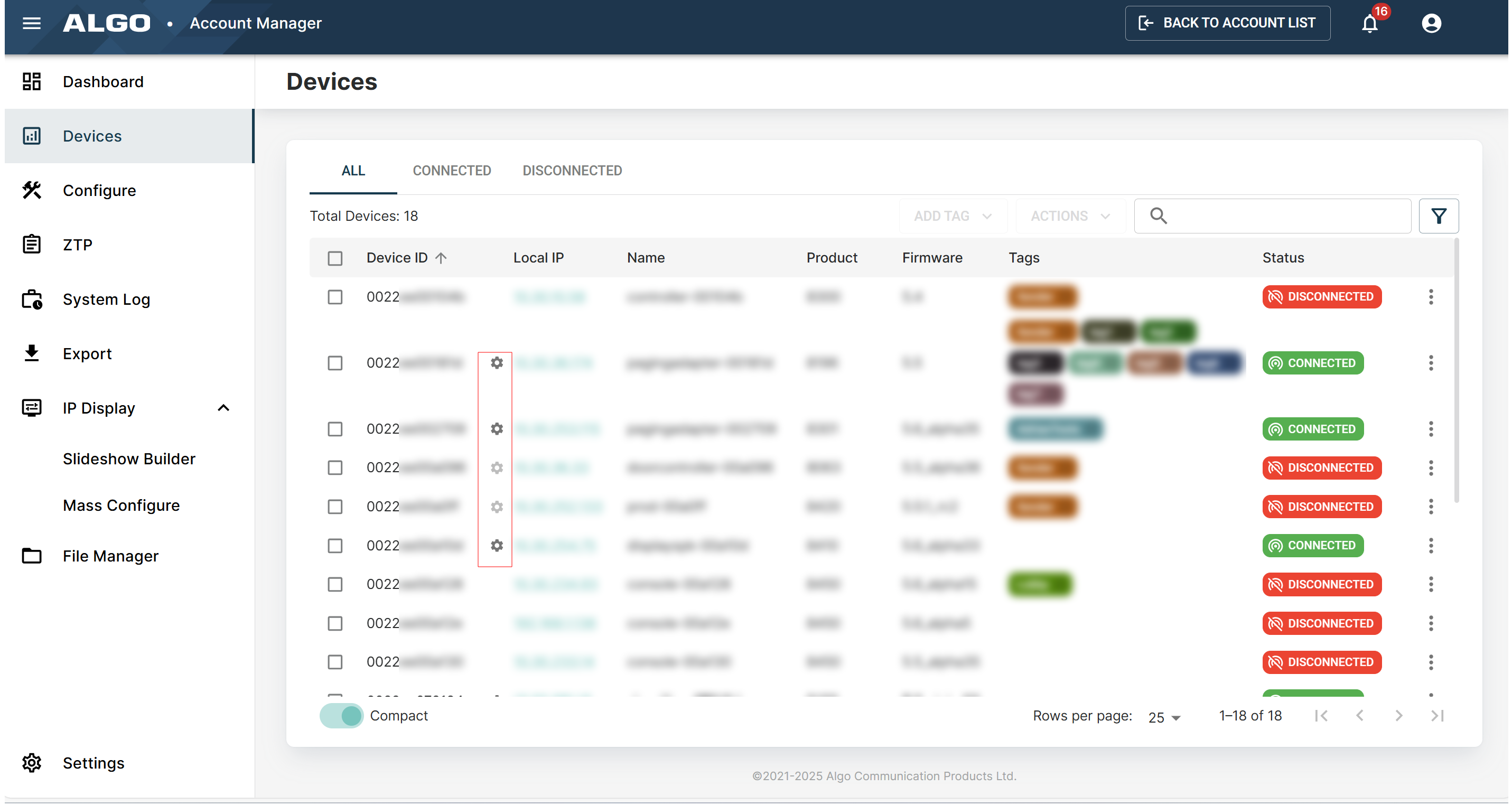
To access Remote Device UI:
Log in to your ADMP application.
Go to the Devices page.
Select the CONNECTED tab.
Select the Remote Device UI
.png) icon next to the desired device.
icon next to the desired device..png)
To exit the Remote Device UI screen:
Select the Exit
.png) icon on the top right of the Remote Device UI screen.
icon on the top right of the Remote Device UI screen.
.png)
Changing Device Settings from Remote Device UI
You can change device settings using the Remote Device UI feature.
To change device settings from the Remote Device UI:
Log in to your ADMP application.
Go to the Devices page.
Select the CONNECTED tab.
Select the Remote Device UI
.png) icon next to the desired device.
icon next to the desired device.Make desired configuration changes, and then select PUSH TO DEVICE.
This operation updates the device configurations and closes the Remote Device UI.
Saving Configuration Changes as Draft
If you attempt to exit the remote device UI without pushing the configuration to the device, you can save configuration changes as a draft.
.png)
If you select SAVE DRAFT, the next time you open the remote device UI, you are prompted to resume editing or delete the draft.
.png)
Configuring the System
You can add or delete device tags or disable devices from mass configuration.
You can also add or remove tags from the Devices page. To customize tag colors, create tags from the Configure page.
.png)
Managing Tags
Tags help describe devices in more detail and allow you to filter them by tag text.
You can create or delete tags.
You can apply up to eight tags to a device.
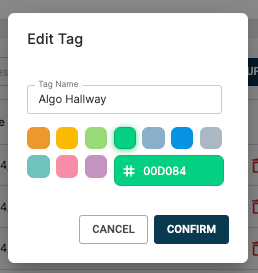
To create new tags:
Log in to your ADMP application.
Go to Configure.
Select + ADD TAG.
Enter a tag name.
Select a tag color. To customize the color, enter a Hex color code, such as #6CC4.
Select Confirm.
To edit an existing tag
Log in to your ADMP application.
Go to Configure.
Select an existing tag.
Change the tag name or tag color. To customize the color, enter a Hex color code, such as #6CC4.
Select Confirm.
To delete a tag:
Log in to your ADMP application.
Go to Configure.
In the Tags section, select the Delete icon
 on the desired tag.
on the desired tag.When asked to confirm the action, select DELETE.
Note
If you try to delete a tag that is currently in use, the system will prompt you and display the devices affected. Deleting the tag will also automatically remove it from all associated devices.
Excluding Devices From Mass Configuration
You can exclude devices when a mass configuration is initiated. Any devices added have a Lock icon ![]() on the left side of the device’s row on the Devices page.
on the left side of the device’s row on the Devices page.
Note
Devices that are disabled from mass configuration can still be configured individually on the Devices page by using the More icon on the right side of the device’s row.
.png)
To exclude devices from mass configuration:
Log in to your ADMP application.
Go to Configure.
In the Disabled Devices for Mass Config section, select + ADD DEVICES.
Select the desired devices and then select Disable.
In the Devices page, a Lock icon
.png) appears on the left of the device entry.
appears on the left of the device entry.(1).png)
Zero-Touch Provisioning (ZTP)
The Zero Touch Provisioning (ZTP) service automatically directs devices to a server during startup to download their configuration files. This makes deploying many devices faster and easier in large settings like schools, factories, or businesses.
Note
All Algo IP endpoints shipped after November 2022 support Zero Touch Provisioning (ZTP). Devices shipped before November 2022 do not have ZTP enabled by default, even after a firmware upgrade. To enable ZTP on these devices, please contact Algo Support.
ZTP is enabled on Algo devices by default. However, the setting is disabled as soon as you manually configure the device. ZTP remains active only during the initial installation or after a factory reset.
Security
ZTP is secured using TLS mutual authentication with certificates. Each Algo IP endpoint has a unique device certificate installed at the factory, tied to its MAC address.
When the device boots up, it automatically connects to Algo’s ZTP server (ztp.algosolutions.com) and establishes a secure TLS connection using its device certificate. This ensures all data transferred is fully encrypted.
Once a MAC address is registered in the ZTP configuration, it is locked to that account and cannot be claimed by another—preventing accidental or malicious hijacking. However, if the MAC address is removed from the configuration, it becomes available to be claimed by another account.
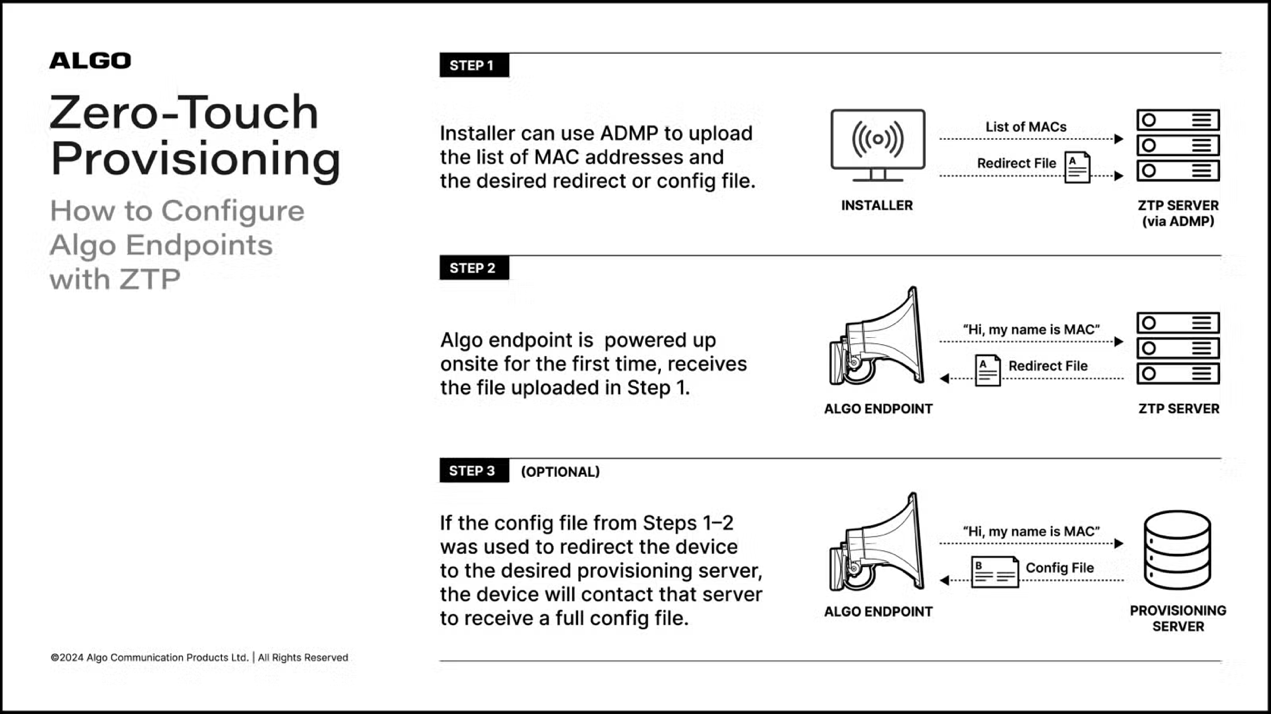
Using ZTP Service
Follow these steps to use the ZTP service:
Obtain ZTP service if you currently do not have it.
If you don’t currently have ZTP service, contact Algo Support to request access.
Upload configuration files
Upload a list of device MAC addresses and a redirect or configuration file to the ZTP server (ztp.algosolutions.com).
Map configuration files to devices
After the mapping is done, when the Algo endpoint is powered on for the first time, it automatically connects to the ZTP server and retrieves the redirect or configuration file associated with its MAC address.
Obtaining ZTP Service
Algo’s ZTP service is free and can be accessed through ADMP. While full ADMP access requires a license, no license is needed to use ZTP.
You can request a ZTP-only ADMP account free of charge. A ZTP-only account holder can only configure mass provisioning for devices, but they can not manage devices. However, you can add a device management license to your ZTP-only account at any time.
Devices shipped before November 2022 do not have ZTP enabled by default, even after a firmware upgrade. To enable ZTP on these devices, please contact Algo Support.
To obtain a ZTP-only account:
Submit a ZTP request form.
Creating Configuration Files
It is recommended that you download an existing device configuration file and use it when creating a custom one.
To download a configuration file from the device web interface:
Log in to your ADMP application.
Go to System → Maintenance.
Select Download Configuration File from the Backup / Restore Configuration section.
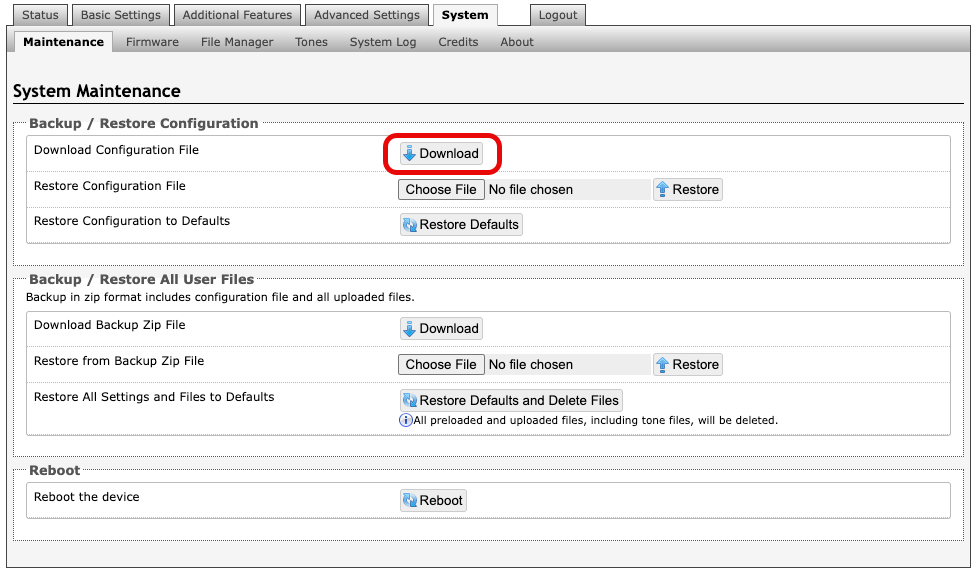
Configuration File Requirements
Observe the following requirements to create your configuration files for use with ZTP:
It must be in the format .txt
It must be a valid Algo configuration file. Any settings not specified in the file will retain their default factory values.
To redirect your devices to a provisioning server, your configuration file should contain:
prov.server.method = static prov.server.static = https://some-local-server prov.sync.endtime = 03:00:00 prov.sync.frequency = daily prov.sync.time = 02:00:00 prov.use = 1 prov.i = 1
To enable ADMP cloud monitoring on your device, your configuration file must contain:
iot.mqtt.ka = 30 iot.tenant = [ADMP account ID] iot.use = 1 iot.sync.conf = 1
Where:
iot.useEnable the device to connect to ADMP.iot.tenant: Specify the ADMP account that the device wishes to connect to.iot.syn.conf: Allow the device to send its configurations to ADMP..
Note
Algo’s ZTP service is primarily meant to redirect traffic to your provisioning server. While it will accept files containing additional settings, such as SIP parameters, it is not intended for this purpose.
Related Links:
Uploading Configuration Files
You must upload the desired configuration files and associate them with device Mac addresses.
To upload a new configuration file:
Log in to your ADMP application.
Select ZTP and then select Configuration Files
 .
..png)
Drag and drop your configuration file into the window or browse and select your files.
Select UPLOAD.
To view the configuration file content, select the View icon
 on the file entry.
on the file entry.
Mapping Devices with Configuration Files
You must map devices to their configuration files using their MAC addresses. When using ZTP, once a MAC address has been claimed by an ADMP account, it cannot be claimed by another. If the MAC address is removed from ADMP, it may be claimed by another account.
.png)
Item | Description |
|---|---|
MAC Address | The MAC address of an added device. A device MAC address can be found on the Status → Device Status page of the device web interface. |
Config File | The selected configuration file is to be applied to the device using ZTP. |
Last Contacted | The most recent date the device contacted ADMP. |
Last Modified | The most recent date the device mapping was modified. |
Provisioned | Whether or not a device has been successfully provisioned. If part of your provisioning includes connecting the device to ADMP, you will be able to use the primary Device and Configure pages of ADMP for additional configuration. |
To add devices for ZTP provisioning:
Log in to your ADMP application.
Select ZTP.
Click + ADD DEVICES.
Do one of the following:
Upload a .txt file containing a list of MAC addresses for your devices.
You can use a comma, tab, or line break to separate MAC addresses in your .txt file.
Enter the list of MAC addresses directly into the window.
You can use a comma, tab, or line break to separate MAC addresses.
Select a configuration file from the drop-down menu.
Select CONFIRM.
When a device with a matching MAC address powers on for the first time, it connects to the ZTP server, retrieves its configuration, and automatically applies the settings.
.png)
Modifying the Device Mapping
You can modify the mapping if you make an error and want to change the configuration file.
This must be done before the device boots up for the first time. Otherwise, the change will not take effect.
To modify the device mapping:
Log in to your ADMP application.
Select ZTP.
Do one of the following:
To modify multiple mappings at a time, select all devices and click MODIFY.
To modify a single device, select the More icon
.png) on the device entry and then select Modify.
on the device entry and then select Modify.
Select a new configuration file.
Select CONFIRM.
System Log
The system log records user actions and changes made in ADMP. This makes it easy to audit or troubleshoot your ADMP account. This data is stored in ADMP for up to a year.
.png)
Recorded device details include:
|
|
Additional ADMP details include:
|
|
To audit and troubleshoot devices, the system log provides a list of ADMP user actions related to device configuration for up to a year.
Actions recorded in the System Log include:
|
|
It should be noted that:
All ADMP account users will have access to the System Log
Actions that have failed will not be reported in the System Log
Details at the specific device level will not be reported (ex. accessory fault detection)
Exporting System Log File
You can download the system logs to assist with system auditing or troubleshooting.
To export the system log file:
Log in to your ADMP application.
Go to System Log.
Select Export at the top right of the screen.
The system log is exported as a .csv file and saved to your computer's default download folder.
Backing Up Device Configurations
If your device is on firmware 5.3 or later, you can download the device configuration file and data.
This helps to assist device troubleshooting or restore device configurations in case of device failure.
Note
Backup of a device's configuration file may fail if the device is busy or disconnected.
Your device must be on firmware 5.3 or later.
Clicking Generate Backup allows you to download a ZIP of all configuration files used on connected devices.
.png)
To download the device configuration:
Log in to your ADMP application.
Go to Export.
Under Step 1: Backup, select GENERATE BACKUP.
This generates a ZIP file containing a copy of the configuration of all the devices. Depending on the number of devices, this may take a minute or two.
Select DOWNLOAD BACKUP FROM: [Date] when this option is available.
This downloads the configuration files as ADMP device export.zip to your computer’s default download folder.
.png)
Note
Download the configuration files in time. The DOWNLOAD BACKUP FROM: [Date] option will be available for three days.
When you click download, a ZIP file will be downloaded. After you unzip the file, you’ll find various .txt files for your products as well as a file called ADMP device export report.csv.
.png)
Open ADMP device export report.csv to review the data. This report will include a list of devices and the number of successful, failed, and skipped devices.
Exporting Device Data
You can export the list of devices monitored by ADMP, along with their basic information, such as MAC address, connection status, and tags.
This is helpful for internal auditing, especially if this data is exported on a regular basis.
The following device data is exported:
Item | Description |
|---|---|
Device ID | The MAC address of your device. |
Status | Device connection status to ADMP. |
Device Name | The product name of your device. |
Product ID | The SKU number of your device. |
Firmware Version | The firmware version the device is currently using. |
Tags | Tags added to the device. |
To export device data:
Log in to your ADMP application.
Go to Export.
Select EXPORT in the Export Device Data section.
The device data is exported as a .csv file and saved to your computer’s default download folder.
File Manager
You can use the File Manager to upload configuration files, images for creating slides, or tones.
You can also manage files, such as previewing, editing, or deleting.
Note
Your file names can only contain alphanumeric characters, dashes, or underscores.
.png)
Note
If you uploaded configuration files via the Configure page in earlier versions of ADMP, you can still access them in File Manager.
There is no need to re-upload the files.
Configs Folder
This folder contains device configuration files. You can upload, view, edit, download, or delete configuration files.
The file can be named anything you would like. However, the following is necessary for a configuration file to be used in ADMP:
It must be in the format .txt
It must be a valid Algo configuration file or a partial Algo configuration file.
A partial configuration file is a provisioning file that contains only selected settings rather than the full configuration of a device.
Partial configuration is recommended when you want to reconfigure some but not all settings across several devices.
Tones Folder
Custom audio files may be uploaded to play notifications. Audio files should be stored in the tones directory.
Audio files must satisfy the following requirements:
• WAV or MP3 format
• Smaller than 200 MB
File names must be limited to 32 characters, with no spaces.
For further instructions, reference the Custom Tone Conversion and Upload Guide.
Images Folder
This folder contains images to be used for building slides for use with IP speakers.
Managing Files in File Manager
You can upload, view, or manage device configuration files, images, or tones in the File Manager.
.png)
Note
Available operations vary depending on the file type.
For example, you can not edit a tone file or delete system default images and tones.
To upload a new file:
Log in to your ADMP application.
Go to File Manager.
Select a target folder:
Configs: Select this folder to upload device configuration files.
Images: Select this folder to upload images to be used with your IP speakers.
Tones: Select this folder to upload audio files to be used with various events.
Do one of the following:
Select UPLOAD and select files from your computer.
Drag and drop files into the folder.
To preview a file:
Log in to your ADMP application.
Go to File Manager.
Select a target folder.
Right-click a file and then select Preview.
To rename a file:
Log in to your ADMP application.
Go to File Manager.
Select a target folder.
Right-click a file and then select Rename.
Enter the new name.
To delete a file:
Log in to your ADMP application.
Go to File Manager.
Select a target folder.
Right-click a file and then select Delete.
To edit a file:
Log in to your ADMP application.
Go to File Manager.
Select a target folder.
Right-click a file and then select Edit.
IP Display
The IP Display feature allows you to configure connected 8410 IP Display Speakers or 8420 Dual-Sided IP Display Speakers in bulk.
For example, you can create and deploy slides or slideshows for regular visuals such as weekly announcements, clocks, or reminders.
Additionally, you can trigger the strobe light for each slide or slideshow. Moreover, you can bulk configure the connected Algo IP Display devices to specify which slides, tones, or strobe lights the 8410 or 8420 should activate when a relay, callbox, announcement, or emergency alert is triggered.
This feature is beneficial for ensuring consistent content and device behavior across all IP displays in large-scale deployments.
Creating Slides
You can create slides using the Slideshow Builder.
These slides can be displayed on the IP Display screen or grouped together to present as a slideshow.
.png)
You can preview the slide effect while you are creating it.
.png)
Creating a Static Image Slide
You can create image-based slides, add still or scrolling text for additional information, and optionally enable a strobe light to display with the slide.
The strobe light is especially useful for drawing attention during emergency alerts.
.png)
To create a static image slide:
Log in to your ADMP application.
Go to IP Display → Slideshow Builder.
Select Create at the top right of the page.
Select Slide.
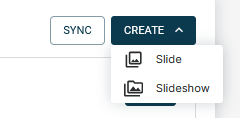
Enter a unique Slide Name at the top of the screen.
Select Image for the Slide Type option.
Select an image using UPLOAD IMAGE.
Note
Make sure the image file name contains only alphanumeric characters, dashes, or underscores. Otherwise, the uploading will fail.
(Optional) Set a Background Color.
If your image doesn’t fill the whole IP Display screen, the background color displays.
(Optional)Specify whether to display text on top of the image:
None: No text.
Static: Displays still text. You need to specify the following also:
Text Input: Enter the text to display on top of the image.
Position: Set the location of text on the screen.
Text Color: Set the color of the text.
You can pick a color or enter the color HEX value.
Text Font: Set the font of the text.
Size: Set the size of the text.
The text size must be between 50 and 300.
Scroll: Displays scrolling text. You need to specify the following also:
Text Input: Enter the text to display on top of the image.
Position: Set the location of text on the screen.
Scroll Speed: Set how fast the text shall scroll.
Text Color: Set the color of the text.
You can pick a color or enter the color HEX value.
Text Font: Set the font of the text.
Size: Set the size of the text. The text size must be between 50 and 300.
(Optional) Under Strobe Setting → Flash Pattern, set whether to activate the strobe light when the slide displays:
Off: No strobe light.
<Flash_pattern_name>: Activate the strobe light with this light pattern. You need to specify the following also:
Brightness: Set the brightness of the strobe light: Low, Medium, or High.
Color: Set the color of the strobe light.
Click Save Slide.
The slide is saved to the Slides section in the Slideshow Builder.
Creating a Flashing Slide
You can create flash-based slides to display two images alternating back and forth. This is helpful to draw extra attention to a message or alert.
.png)
To create a flashing slide:
Log in to your ADMP application.
Go to IP Display → Slideshow Builder.
Select Create at the top right of the page.
Select Slide.

Enter a unique Slide Name at the top of the screen.
Select Flashing Image for the Slide Type option.
Select two images using UPLOAD IMAGE.
Note
Make sure the image file name contains only alphanumeric characters, dashes, or underscores. Otherwise, the uploading will fail.
(Optional) Under Strobe Setting → Flash Pattern, set whether to activate the strobe light when the slide displays:
Off: No strobe light.
<Flash_pattern_name>: Activate the strobe light with this light pattern. You need to specify the following also:
Brightness: Set the brightness of the strobe light: Low, Medium, or High.
Color: Set the color of the strobe light.
Click Save Slide.
The slide is saved to the Slides section in the Slideshow Builder.
Creating an Analog Clock Slide
You can create an analog clock slide to display the current time.
It provides a clear, traditional clock face that can be customized with background color, outline color, and an optional seconds hand.
.png)
To create an analog clock slide:
Log in to your ADMP application.
Go to IP Display → Slideshow Builder.
Select Create at the top right of the page.
Select Slide.

Enter a unique Slide Name at the top of the screen.
Select Analog Clock for the Slide Type option.
(Optional) Set a Background image.
Configure the clock outlook:
Clock Color (Background): Set the clock background color.
You can pick a color or enter the color HEX value.
Clock Color (Foreground): Set the clock outline color.
You can pick a color or enter the color HEX value.
Show Seconds Hand: Enable or disable the seconds hand display.
Seconds Hand Color: Set the second hand color.
You can pick a color or enter the color HEX value.
(Optional) Under Strobe Setting → Flash Pattern, set whether to activate the strobe light when the slide displays:
Off: No strobe light.
<Flash_pattern_name>: Activate the strobe light with this light pattern. You need to specify the following also:
Brightness: Set the brightness of the strobe light: Low, Medium, or High.
Color: Set the color of the strobe light.
Click Save Slide.
The slide is saved to the Slides section in the Slideshow Builder.
Creating a Digital Clock Slide
You can create a digital clock slide to display the current time. It provides clear, concise time information, and you can customize the time style.
You can also add text to the screen or activate the strobe light to draw additional visual attention.
.png)
To create a digital clock slide:
Log in to your ADMP application.
Go to IP Display → Slideshow Builder.
Select Create at the top right of the page.
Select Slide.

Enter a unique Slide Name at the top of the screen.
Select Digital Clock for the Slide Type option.
(Optional) Set a Background Image.
Note
Make sure the image file name contains only alphanumeric characters, dashes, or underscores. Otherwise, the uploading will fail.
(Optional)Specify whether to display text along with the clock:
None: No text.
Static: Displays still text. You need to specify the following also:
Text Input: Enter the text to display on top of the image.
Position: Set the location of text on the screen.
Text Color: Set the color of the text.
You can pick a color or enter the color HEX value.
Text Font: Set the font of the text.
Size: Set the size of the text. The text size must be between 50 and 300.
Scroll: Displays scrolling text. You need to specify the following also:
Text Input: Enter the text to display on top of the image.
Position: Set the location of text on the screen.
Scroll Speed: Set how fast the text shall scroll.
Text Color: Set the color of the text.
You can pick a color or enter the color HEX value.
Text Font: Set the font of the text.
Size: Set the size of the text. The text size must be between 50 and 300.
Configure the clock outlook:
Clock Color (Background): Set the clock background color.
You can pick a color or enter the color HEX value.
Clock Color (Foreground): Set the clock outline color.
You can pick a color or enter the color HEX value.
Time Format: Set the time style to 12-hour (for example: 03:45 PM) or 24-hour (for example: 15:45).
Show Clock Seconds: Enable or disable the seconds display.
Enable the seconds if you want precise timing, or disable it for a cleaner look.
(Optional) Under Strobe Setting → Flash Pattern, set whether to activate the strobe light when the slide displays:
Off: No strobe light.
<Flash_pattern_name>: Activate the strobe light with this light pattern. You need to specify the following also:
Brightness: Set the brightness of the strobe light: Low, Medium, or High.
Color: Set the color of the strobe light.
Preview the slide.
Click Save Slide.
The slide is saved to the Slides section in the Slideshow Builder.
Creating Slides Using Preconfigured Templates
You can quickly create slides using a variety of preconfigured templates. These templates cover the most commonly used slide types, such as announcements, clocks, and calendar displays.
You can also add strobe lights, text, or a company logo to some templates.
.png)
To create a slide using a template:
Log in to your ADMP application.
Go to IP Display → Slideshow Builder.
Select Create at the top right of the page.
Select Slide.

Enter a unique Slide Name at the top of the screen.
Select Template for the Slide Type option.
Select a template from the Templates drop-down list.
(Optional) To display an icon, such as your company logo, select an existing icon from the Icon drop-down list.
You can also select UPLOAD ICON to add an icon to the drop-down list.
If the template allows text, strobe light, or clock settings, configure them as desired.
Creating Slideshows
Once you have created your slides, you can organize them into slideshows for display on IP Display screens.
Slideshows are perfect for showcasing daily announcements, schedules, reminders, and other routine updates.
Additionally, you can create new slides on the fly while you are building a slideshow.
.png)
To create a new slideshow:
Log in to your ADMP application.
Go to IP Display → Slideshow Builder.
Click Create at the top right of the page. Click Slideshow.
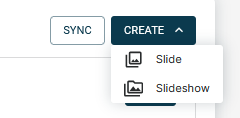
Enter a Slideshow Name at the top of the window.
To change how long each slide displays, change the Seconds under Slide Duration.
By default, Slide Duration is set to 3 seconds.
To apply a strobe setting to go with all slides, enable the Global Strobe Setting and configure the Flash Pattern:
Off: No strobe light.
<Flash_pattern_name>: Activate the strobe light with this light pattern. You need to specify the following also:
Brightness: Set the brightness of the strobe light: Low, Medium, or High.
Color: Set the color of the strobe light.
By default, the Global Strobe Setting is turned off.

Click Add Slide on the left side of the window. Do one of the following:
To create new slides on the fly, select New Slide.
To use slides you previously created, select Existing Slides and select the desired slides.
.png)
To edit the slideshow, do one of the following:
.png)
To add more slides, select ADD SLIDE.
To change the order of a slide, drag and drop it to the desired position.
To delete a slide, select Delete from the More icon
 below the slide.
below the slide.
Select SAVE SLIDESHOW.
The slide is saved to the Slideshows section in the Slideshow Builder.
Previewing a Slide or Slideshow
You can preview a slide or slideshow after creating it.
The file settings are also displayed in the Preview window.
Additionally, you can edit the file directly from the preview window.
.png)
To preview a slide or slideshow:
Log in to your ADMP application.
Go to IP Display → Slideshow Builder.
Select a slide or slideshow.
The preview displays on the right side of the screen.
To stop the slideshow preview, select STOP.
Editing a Slide or Slideshow
You can edit a slide or slideshow after you have created it.
To edit a slide or slideshow:
Log in to your ADMP application.
Go to IP Display → Slideshow Builder.
Select a slide or slideshow.
The preview and file settings are displayed on the right side of the screen.
Select Edit.
Change the slide or slideshow, then select SAVE SLIDESHOW or SAVE SLIDE.
Importing Slides and Slideshows into ADMP
You can export existing slides and slideshows from 8410 or 8420 and import them into ADMP.
Follow these steps:
Step 1: Exporting Images and Icons from an IP Display
These files are required for the slides or slideshows.
Step 2: Exporting Slide and Slideshow Data File from an IP Display
This file contains the configuration details of the existing slides and slideshows on the device.
Step 3: Uploading Images and Icons into ADMP
Upload the images and icons, so ADMP has the necessary resources to recreate the slides and slideshows.
Step 4: Importing Slides and Slideshows Data File into ADMP
Upload the configuration file to allow ADMP to reconstruct the slides and slideshows.
Step 1: Exporting Images and Icons from an IP Display
You must export all images and icons used by the slides or slideshows. To make it easier, download all icons and images from the IP display.
To export Images and Icons from an IP Display
Log in to your desired IP Display’s web interface.
Go to System → Maintenance.
In the Backup / Restore All User Files section, select Download next to Download Backup Zip File.
This downloads the device configuration settings and the files in the File Manager.
A .zip file named allfiles-[device name]-[MAC address].zip is saved to your computer’s default download folder.
Select the .zip file. Right-click it and select Extract All from the context menu.
You will upload the files of the images and icons folder in the ADMP File Manager later.
.png)
Step 2: Exporting Slide and Slideshow Data File from an IP Display
You can export the slide and slideshow data file from an IP display. The data file contains the configuration details for the existing slides and slideshows on the device.
After importing the images and data file into ADMP, ADMP can automatically reconstruct the slides and slideshows.
To export the slide and slideshow database file:
Log in to your desired IP Display’s web interface.
Go to Display → Data.
In the Backup / Restore Data section, select Download next to Download Slide Data File.
A database file named display-[device name]-[MAC address].db is saved to your computer’s default download folder. You will need to import this file into ADMP later.
Step 3: Uploading Images and Icons into ADMP
You need to upload the images and icons used in the slides and slideshows, so ADMP has the necessary resources to recreate them.
Log in to your ADMP application.
Go to File Manager → Images.
Select UPLOAD. Then navigate to your extracted allfiles-[device name]-[MAC address] folder.
Select all files in the images folder and then select Open.
Go to File Manager → Icons.
Select UPLOAD. Then navigate to your extracted allfiles-[device name]-[MAC address] folder.
Select all files in the icons folder and then select Open.
The files appear in the Images and Icons folders of the ADMP File Manager.
Step 4: Importing Slides and Slideshows Data File into ADMP
You must upload the configuration file to allow ADMP to reconstruct the slides and slideshows.
To import slides and slideshows into ADMP:
Log in to your ADMP application.
Go to IP Display → Slideshow Builder.
Select Create → Import.
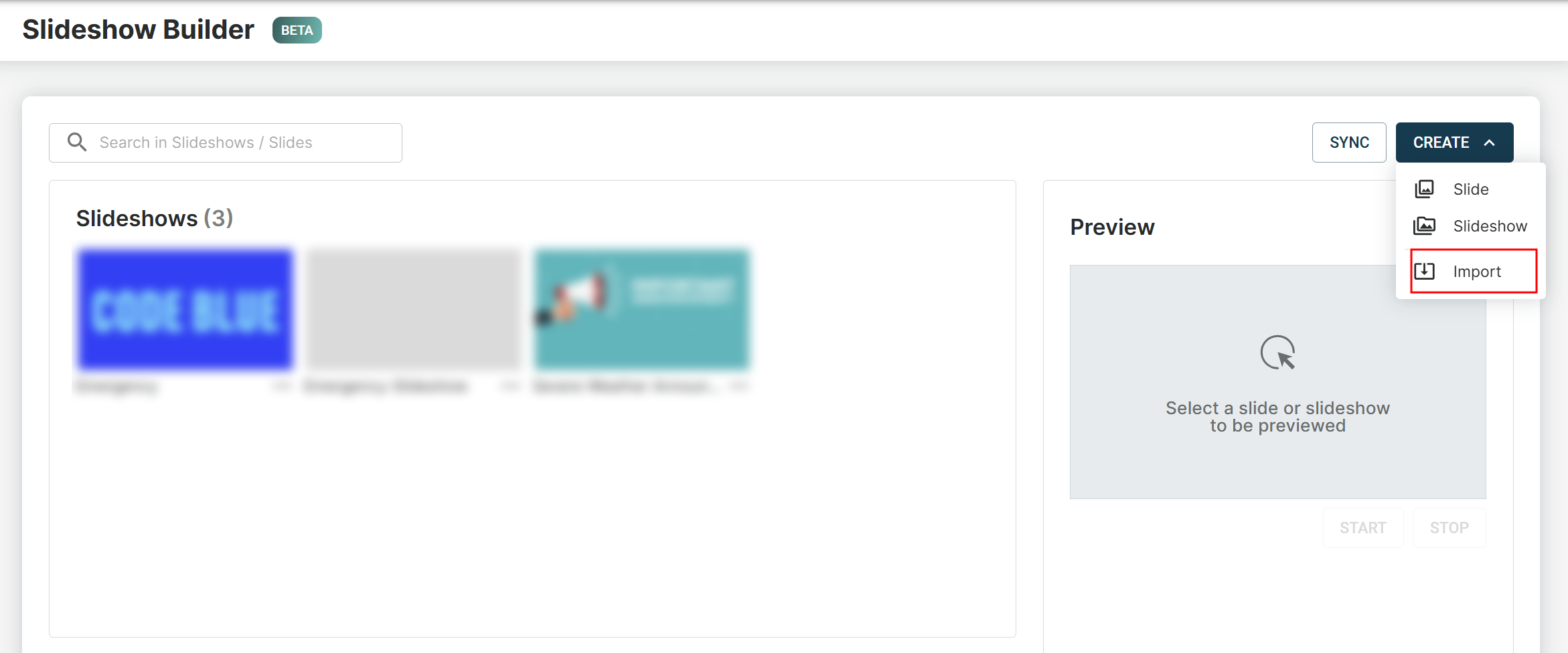
Do one of the following:
Locate your display-[device name]-[MAC address].db file. Drag and drop it into the import area.
Select Choose files. Then navigate to the display-[device name]-[MAC address].db file and select Open.
Select IMPORT.
.png)
If your slide or slideshow name duplicates an existing one in ADMP, you are prompted to choose an action and then select FINISH IMPORT.
Skip: Do not import the duplicate slide or slideshow. The existing file with the duplicate name in ADMP will remain unchanged.
Import as copies: Import the duplicate slide or slideshow with a new name. For example, if the duplicate file is named "shelter," the imported file will be named "shelter-copy".
Replace: Import the duplicate slide or slideshow and overwrite the existing one in ADMP.
You can now find the recreated slides and slideshows in the Slideshow Builder.
Pushing Slides and Slideshows to IP displays
You can push all created slides or slideshows to connected Algo IP Displays.
Upon successful operation, all slides, slideshows, and associated images are pushed to the selected IP Display devices.
You can find them in the device’s web interface:
Slides are added to the Display → Slides.
Slideshows are added to the Display → Slideshows section.
The associated images are added to the images folder in System → File Manager.
When you perform the SYNC action in ADMP, existing slides and slideshows in ADMP are added to the selected devices. If a file with the same name already exists on a device, it will be overwritten. However, any files that exist only on the device and are not in the ADMP will remain unchanged.
Note
The target IP Displays must have the status CONNECTED before you can push slides or slideshows to them.
.png)
To push all slideshow configurations to connected 8410 and 8420 devices:
Log in to your ADMP application.
Go to IP Display → Slideshow Builder.
Select Sync at the top right of the page, then select Proceed.
The system automatically selects the IP Display devices with different slides and slideshows.
(1).png)
Select SYNC.
When asked for confirmation, select PROCEED.
All slides, slideshows, and associated images are pushed to the selected IP Display devices.
Mass Configuring Algo IP Display Devices
You can bulk configure connected Algo IP Display devices to define which slides, tones, or strobe lights the 8410 or 8420 should activate when a relay, callbox, announcement, or emergency alert is triggered.
Mass configuration enables efficient deployment and ensures consistent device behavior across all IP Display devices.
.png)
Creating New Configuration Files
You can create up to 20 configuration files.
In a configuration file, you can define which slides, tones, or strobe lights the 8410 or 8420 device should activate when a relay, callbox, announcement, or emergency alert is triggered.
To create a new configuration file:
Log in to your ADMP application.
Go to IP Display → Mass Configure.
Click + New Config on the top right of the page.
Enter a File Name for your configuration file.
The file names can only contain alphanumeric characters, dashes, or underscores.
Give the configuration file a clear, descriptive name to make it easy to identify later.
Use the drop-down menus to select a slide or slideshow to appear when an action is triggered.
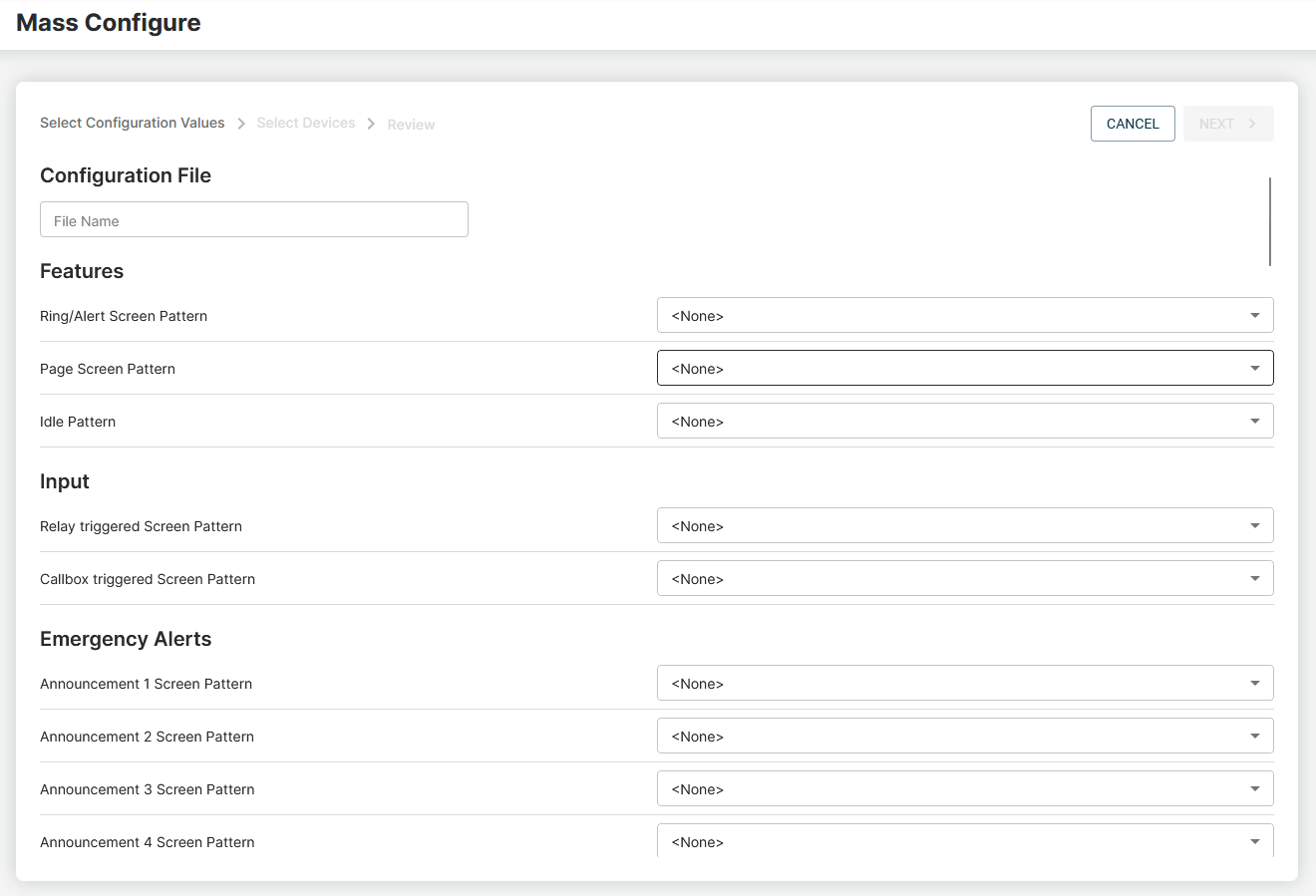
Select Next.
Select the IP Display devices to apply the new configuration file to.
Note
The target devices must be of the status CONNECTED.
Review the configuration settings and click Push to Device.
.png)
Upon successful operation, the configuration takes effect on the selected devices.
Editing a Configuration File
You can edit the existing configuration file.
To edit a configuration file:
Log in to your ADMP application.
Go to IP Display → Mass Configure.
Select Edit from the More icon
 on the right side of the desired configuration file.
on the right side of the desired configuration file.
Configuration File
This table lists the configuration file entries and explains how each setting affects the content displayed on the 8410 or 8420 LCD screen.
Features | Description |
|---|---|
Ring/Alert Screen Pattern | Select a screen pattern to display for inbound ring events. |
Page Screen Pattern | Select a screen pattern to display for inbound page events. |
Idle Pattern | Select a pattern to be displayed on the screen for when the 8410 or 8420 is idle. Patterns can include up to several screen displays and can vary to include a single image, a notification template, a clock display, and other configurations. |
Input | Description |
|---|---|
Relay triggered Screen Pattern | Select a screen pattern to display on the screen when a relay-triggered event happens. |
Callbox triggered Screen Pattern | Select a screen pattern to display on the screen when a callbox-triggered event happens. |
Emergency Alerts | Description |
|---|---|
Announcement N Screen Pattern (N = 1 - 10) | Select a pattern to display on the screen when announcement N is triggered. |
More Page Extensions - Basic Extensions | Description |
|---|---|
All Call Page Extension (Poly Group 8) | Select a screen pattern to display when All Call page extension is dialled. |
Screen Pattern N (Zone N) (N = 1 - 6) | Select a screen pattern to display when page extension N (N =1 - 6) is dialled. |
Music page extension (Poly Group 7) | Select a screen pattern to display when the music page extension is dialled. |
More Page Extensions - Expanded Extensions | Description |
|---|---|
Screen Pattern N (Zone N) (N= 10 - 50) | Select a screen pattern to display when page extension N (N = 10 - 50) is dialled. |
More Ring Extensions | Description |
|---|---|
Screen Pattern N (N = 2 - 10) | Select a screen pattern to display when ring extension N (N = 2 - 10) is dialled. |
Screen-tone Mapping | Description |
|---|---|
Screen Pattern N (N = 1 - 10) | Select a screen pattern to display when tone N (N = 1 - 10) plays. |
Advanced Multicast (Receiver) Screen Patterns - Basic Zones | Description |
|---|---|
Priority Call (DTMF: 9) | Select a screen pattern to display when a priority multicast is triggered. |
All Call (DTMF: 0/8) | Select a screen pattern to display when a multicast to all zones is received. |
Zone 1 (DTMF: 1) | Select a screen pattern to display when a multicast to zone 1 is received. |
Advanced Multicast (Receiver) Screen Patterns - Expanded Zones | Description |
|---|---|
Zone N (DTMF: N) (N= 10 - 50) | Select a screen pattern to display when multicast to zones 10 - 50 is triggered. |
Pushing Configurations to IP Display Devices
You can push a configuration file to connected Algo IP Displays.
Please note the following:
Only valid parameter values are accepted.
Invalid or blank parameters are ignored. No change will be made to these parameters.
To push the configurations to IP Display devices:
Log in to your ADMP application.
Go to IP Display → Mass Configure.
Select Push Config from the More icon
 on the right side of the desired configuration file.
on the right side of the desired configuration file. .png)
Deleting Inconsistent Images from IP Speakers
To maintain consistent content across all IP Display devices, you can bulk delete slides, slideshows, and images that are not stored in ADMP.
This ensures that only centrally managed and distributed content remains on every connected IP Display device.
.png)
To delete slides, slideshows, and images that are not stored in ADMP:
Log in to your ADMP application.
Go to IP Display → Mass Config.
Select a desired configuration file.
Select SYNC.
The list of out-of-sync IP Display devices appears.
Select the desired devices.
Select CLEAN and then select SYNC.
Settings
The Settings screen displays your account settings and license details. 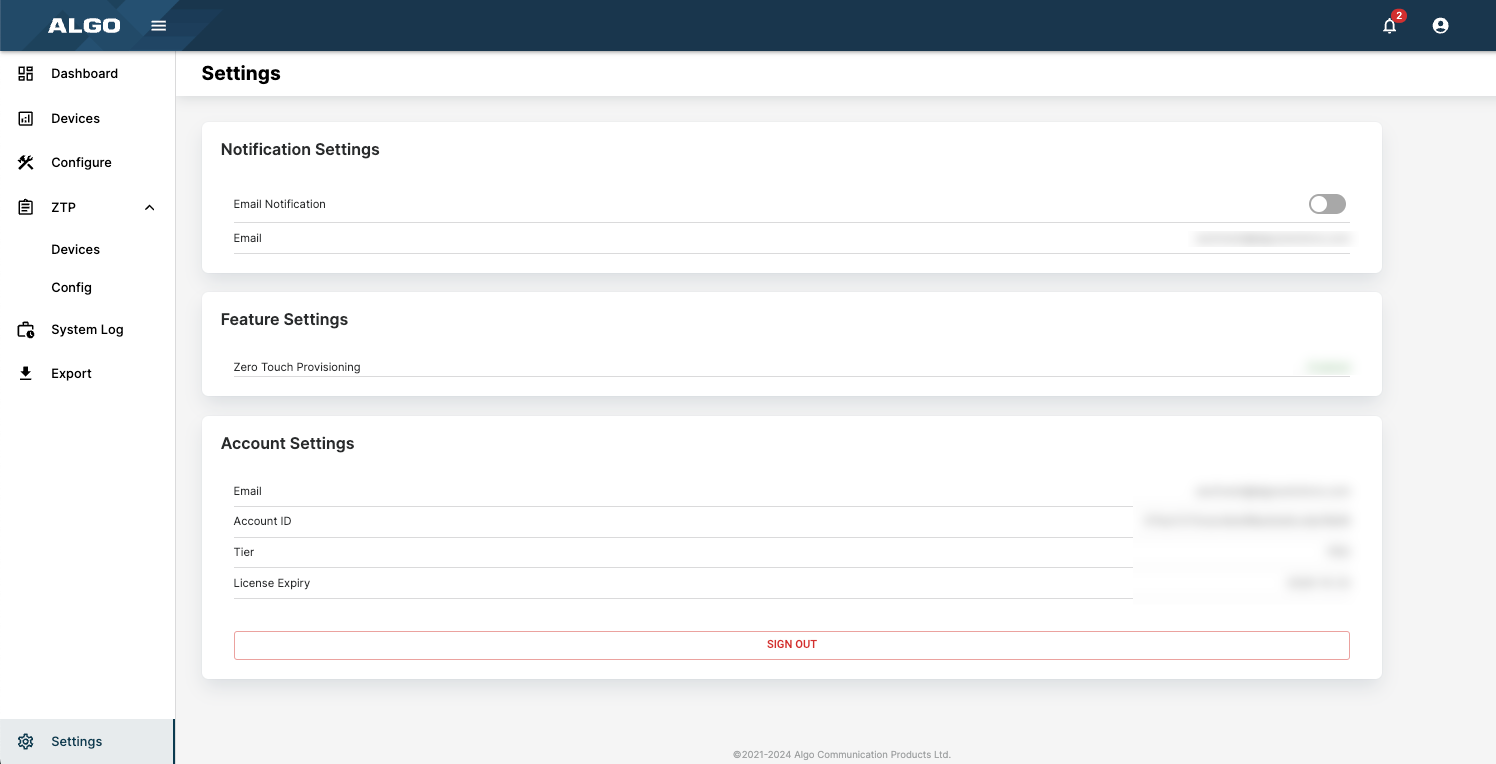
Enabling Email Notifications
You can enable email notifications to keep updated on essential device events.
To enable email notifications:
Log in to your ADMP application.
Go to Settings → Email Notification.
Enable desired event notifications:
Disconnection: You will be notified when your device is disconnected from ADMP.
Back Online: You will be notified when a device is reconnected to ADMP.
Fault Detection: You will be notified of a fault or disconnection between an Algo IP endpoint and accessory device. This includes products like Algo satellite speakers, the Algo 8028 intercom, and call buttons.
Setting Device Table Layout
You can set the layout of the device list in the Devices page.
To set the device table layout:
Log in to your ADMP application.
Go to Settings → Device Table Settings.
Set the following:
Enable Compact View: Enabling this setting will make the rows of the device table shorter to display more devices at a time.
This can also be controlled directly on the Devices page at the bottom of the device table.
Local IP Link Protocol: Select HTTP or HTTPS to use when accessing your devices locally automatically.
This can be helpful to control, depending on the uploaded certificates and your encryption settings.
Rows Per Page: Select the number of rows in the device table to show per page.
Up to 40 can be viewed at a time. This can also be controlled directly on the Devices page at the bottom of the device table.
Feature Settings
This section displays the status of Zero Touch Provisioning.
Zero-touch provisioning is enabled by default.
To disable zero-touch provisioning, please contact the Algo support team.
Viewing Your Account Settings
You can find your account ID, account tier, and license expiry date from the Account Settings.
Setting | Description |
Your email used to log into the ADMP account. | |
Account ID | A unique ID for your company account. An Account ID is required to connect a device to ADMP. |
Tier | There are three kinds of account tiers: Trial, Pro, and Perpetual. See section 2.1 for more details. |
License Expiry | The soonest date any licenses will expire. If you have bought licenses at different times, they will have different expiration dates. However, the date listed here represents when any licenses you have will expire next. |
To view your account settings:
Log in to your ADMP application.
Go to Settings →Account Settings.
Security
Algo takes precautions to mitigate the risk of cyberattacks and builds ADMP with the safety of your data and systems in mind. ADMP and Algo devices use mutual authentication over TLS to ensure that data transferred between ADMP and the device is fully encrypted. This means only Algo devices can be used with ADMP.
ADMP does not store any unencrypted passwords.
Port and Protocols
ADMP uses the following ports and protocols:
Address | Type | Purpose | Protocol | Security | Port | |
iot.cloud.algosolutions.com | TCP | Monitoring and management | HTTPS, MQTT, TLS | TLS 1.2 | 443 | |
files.cloud.algosolutions.com | TCP | File transfer | HTTPS, TLS | TLS 1.2 | 443 | |
dinfo.cloud.algosolutions.com | TCP | Advanced device status and relay supervision | HTTPS, TLS | TLS 1.2 | 443 | |
d1ma5gprn1j2rk.cloudfront.net/ | TCP | Pushing configurations | HTTPS, TLS | TLS 1.2 | 443 | |
firmware.algosolutions.com | TCP | Firmware upgrading | HTTPS | TLS 1.2 | 443 |